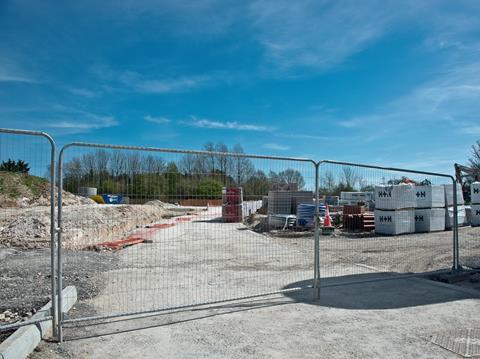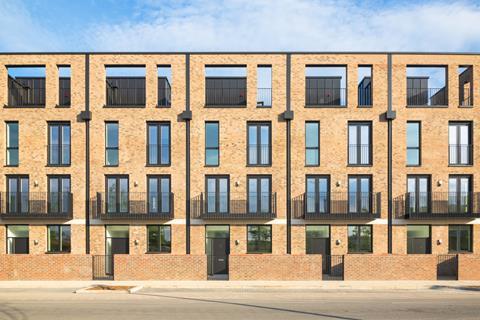The government has admitted that it will not hit its development targets. Joey Gardiner asks what’s really going on and looks at how the situation can turn around

“We do not believe there is any funding gap.” So said junior housing minister Baroness Scott last month, pressed by MPs on the housing select committee over the government’s troubled £11.5bn affordable housing programme.
The social housing sector might take some convincing, however. Even if delivered in full, the government-funded programme, equivalent to around 30,000 homes a year, would produce just a fraction of the 145,000 new affordable homes as necessary each year to meet demand.
But the programme is not delivering fully. Housing associations are setting about a sharp contraction of development in the face of overwhelming economic, financial and policy headwinds. It’s not a threat: the latest official data on affordable housebuilding shows that grant-funded starts of social rent, affordable rent and shared ownership properties collapsed by 60% year-on-year in England in the first half of the 23/24 financial year.
The baroness admitted that the affordable homes programme (AHP) – originally conceived to deliver up to 180,000 homes between 2021 and 2026 – will now deliver fewer homes than planned, but she refused to say exactly how many. So, what is really about to happen to affordable housing delivery, and can anything be done to turn the situation around?
Unforgivable disaster
The drop in build rates is playing out against the slow-moving car crash of the UK’s housing crisis, with its impacts increasingly being felt by those already most disenfranchised and marginalised. Government data shows that housing insecurity is driving increasing levels of homelessness, with year.
A record 139,000 children are legally homeless and housed in temporary accommodation, a situation which Shelter says “”. The council bill for this temporary housing, estimated at £1.7bn annually, could bankrupt “many” local authorities according to the .
“It is an unforgiveable disaster in terms of its impact on people’s lives,” says Stephen Teagle, the boss of Vistry’s Countryside Partnerships business.

Against this grim backdrop, it is no surprise to most in the sector that delivery of the housing programme is under threat. As far back as August 2022, the that “sudden and unforeseen” inflationary pressures had the potential to “significantly affect the success of the programme”.
Just one month later, the it was already expecting the department to undershoot its 180,000-home target by 23,000 homes. Then came the disastrous Kwarteng-Truss mini-Budget.
“Housing associations were hit very badly by the mini-Budget,” says Paul Hackett, chief executive of newly merged London-based association Southern Housing, where development starts will drop to around 250 this year – more than 80% down on the average over the past five years.
“That was the beginning of big impacts to scheme viability with a large, large part of our pipelines being wiped out as a consequence of higher interest rates.”
The collapse in buyer confidence and vast increase in the cost of capital seen in the wake of Truss-Kwarteng prompted rapid action from the bodies overseeing the AHP – Homes England (outside London) and the Greater London Authority (GLA) – and the Department for Levelling Up, Housing and Communities (DLUHC) which sponsors it.
While the GLA had originally been granted £4bn to pay for 35,000 homes, it entered discussions about “re-profiling” the programme in order to save it from failure.
Extremely challenging
Tom Copley, deputy mayor for housing at the GLA, says these discussions ultimately concluded in July last year with Michael Gove agreeing to the GLA delivering just 23,000-27,000 homes for the same funding, a reduction of up to a third. He also claims that arguments between the DLUHC and Treasury meant the GLA had not been permitted to allow partners to start work on any homes until that was agreed, leading to an effective two-year delay in the beginning of the programme.

“It has been extremely challenging,” says Copley. “It has probably been the most difficult and turbulent time for the housing sector in anyone’s memory.”
Delivery has been further hampered by what he calls a “chaotic and haphazard” implementation by the DLUHC of rules requiring second staircases on high-rise buildings. He accepts that, since the completion of the previous 2016-23 affordable housing programme, there has been a “big drop-off” in build rates.
Homes England, likewise, went through a similar “re-profiling” process in 2023 albeit it had not been held up by departmental arguments prior to then so had made more progress beforehand. Shahi Islam, director of affordable housing at the housing quango, says the government gave it extra leeway for the number of homes ultimately produced by grants to be reduced, thereby effectively upping the grant rate.
“We worked very quickly with the department and Treasury to look at how we could support our partners where we knew that schemes could potentially be mothballed or stalled,” Islam says.
He adds that additional flexibilities, such as around the use of recycled capital grant funding, switching tenure on schemes, and using grant for replacing existing homes also enabled schemes to proceed.
Heading south
However, where the GLA is open about the impact that all this has had on how many homes it will build, Homes England has been told it cannot say, even though the re-profiling exercise was completed last summer. Baroness Scott told MPs last month that “we will build as many [affordable homes] as we possibly can”, but refused to say what the revised targets under the programme will be or when they will be published, simply saying they will emerge “in due course”.
If you put all this together, what we’re talking about seriously erodes the development capacity of the sector
David Montague, housing association adviser
Despite this, Homes England’s Islam says it is clear that fewer homes will be built even than was envisaged by the National Audit Office (which had assumed a 35,000 contribution from London and 122,000-130,000 contribution from Homes England). “If you’re introducing higher grant rates and do more social rent, then there will potentially be a compromise on numbers,” he said, agreeing that the overall figure will now be “some way south” of the NAO’s figures.
In numbers: affordable homes programme
The government has allocated £11.4bn to spend on grant-funded affordable homes between 2021 and 2026, split between Homes England, which distributes the cash outside of London, and the GLA, which administers it in the capital.
Completions under the standard programme must be by March 2026, however “strategic partners” have until either March 2028 or 2029 to build out their homes.
| Homes England | GLA | |||
|---|---|---|---|---|
| Funding (£bn) | Homes target (000) | Funding (£bn) | Homes target (000) | |
| Original affordable homes programme | 7.4 | 145 | 4 | 35 |
| National Audit Office assessment (Sep ’22) | 7.4 | 122-130 | 4 | 35 |
| Current estimate | 7.4 | Confidential | 4 | 23-29 |
Source: Department for Levelling Up, Housing and Communities, National Audit Office, Greater London Authority
Of course, while the shock to capital markets from the Truss-Kwarteng “fiscal event” was the immediate prompt for this re-evaluation of the affordable homes programme, the issues driving the difficulties of the sector go far wider. Housing associations, particularly the well-established players traditionally responsible for the bulk of delivery, face a mountain of issues requiring them to invest in their existing homes, including a £10bn fire safety repair bill, a circa £36bn zero carbon investment programme; sorting damp and mould issues, RAAC, and the requirement to meet new consumer regulation standards.
Meanwhile, rents have been repeatedly capped but construction inflation has rocketed. Former L&Q chief executive David Montague, now working as a non-exec at a number of landlords, says: “For a long time, growth has been in housing associations’ DNA. But if you put all this together, what we’re talking about seriously erodes the development capacity of the sector.”
Intense pressure
Housing associations’ balance sheets have been seriously hit. According to the latest “quarterly survey” report by the regulator (the RSH), the aggregate interest cover across the sector – that is the ratio of operating profit against interest payments, has fallen to 74%, the lowest ever recorded – and down from 181% just four years ago.
One long-time adviser operating in the sector says: “The regulator puts a brave face on it and tries to be fairly bullish, but they are concerned.”

With balance sheets under pressure, associations will inevitably look to limit capital spend where they can. Southern’s Hackett says: “The pressure on us is intense at the moment. The one bit of really discretionary spending is development.
“There’s a risk that the sector is seen as crying wolf, but this time it really is terrible. Associations will hand grants back if appraisals don’t work.”
And many suspect that development will not just slow for a year or two. “For at least five years we’ll have a reduction in the commitment to development from the not for profit sector,” says Montague.
So how bad will the affordable build out-rate get?
While Homes England will not yet say how much it has cut its programme by, an equivalent cut to that seen in the capital would see a 50,000-home reduction in the target for homes produced.
Whether the reality is that bad remains to be seen, as London appears by most estimates to have suffered most severely from the difficulties in the market, given it is more reliant on harder-to-fund high-rise schemes, which have also been hit by the second staircase regulations (The GLA’s Copley says 34,000 homes are currently held up in planning by the second staircase issue).
My clients are having an absolute nightmare. They just can’t get housing associations to bid for their section 106 homes […] and the scheme stalls
Advisor to housebuilders
But providers are clear about one thing: that however hard the current official grant-funded programme is hit, the overall delivery of affordable housing is likely to be hit even harder. According to the most recent government figures, just under half of all new affordable homes are generally built without grant funding, either using developer or housing association subsidy.
David Montague says: “Associations are focusing their limited capacity for development on their relationship with Homes England and with the GLA. They don’t want to lose grant if they can.”
Terrifying
So, while associations are working with the GLA and Homes England to honour their contracts where they can, many are very cautious about taking on anything else. “Where they’re thinking long and hard is in their appetite for doing much more than what they’re committed to,” says Hackett.
This is particularly the case with section 106 deals, under which social landlords agree to buy up the affordable housing that private developers are obliged to build under their planning permissions. One adviser working with housebuilders says: “My clients are having an absolute nightmare. They just can’t get housing associations to bid for their section 106 homes, and even when they can get a bid it’s too low and ruins the viability, and the scheme stalls.”
The upshot, the advisor says, is that private schemes are going on hold as developers try to renegotiate planning obligations with the local authority, or see if they can sell the homes to the council itself.

Geeta Nanda, outgoing chief executive of London-based association MTVH and current chair of the G15 group of associations, says her organisation has cut its build programme to 1,000 a year from an ambition to rise to 2,000, and is not doing any section 106 deals. “Our priority is to meet our strategic partnership obligations [with Homes England],” she says.
Overall, the statistics on development of grant-funded affordable housing for the first half of the current financial year show that starts have dropped by 30% year-on-year. However, the G15 group of London-based associations are forecasting a 48% drop in starts overall for the current financial year, to 7,035.
Meanwhile, government figures for affordable starts overall show numbers down by an even more shocking 62% in the third quarter of the calendar year, to just 3,850 across England. MTVH’s Nanda says: “The figures on starts are terrifying. You can see with what’s happening on rough sleeping, on temporary housing, this build-up – it’s really coming to fruition.”
Bright spots
There are some bright spots, however. Partnerships housebuilder Vistry says it is still seeing demand for its schemes utilising its long-term partnerships model, where it blends section 106 provision with grant-funded units, and is also able to take on section 106 units itself as a bona-fide registered provider approved by the regulator.
Vistry’s Teagle, says the firm signed more than 60 contracts in the two months before Christmas with a range of associations, even though the appetite to commit to new schemes was reduced. Moreover, in the 2022/23 financial year, associations did manage to temporarily raise production as the previous (and extended) 2016-23 Affordable Homes Programme closed, with more than 54,000 starts achieved across England. It is only since then that production has really fallen back.
A Department for Levelling Up, Housing & Communities spokesperson said: “We’ve delivered over 696,000 affordable homes since 2010, including 172,000 for social rent, and last year saw the highest levels of housing delivery on record with a 17% increase in starts to the previous year.”
The spokesperson added the government remained on-track to deliver one million homes of all tenures across the parliament, and said the department’s long-term plan for housing, launched last year, will “boost supply and build the homes that local communities want and need.”
In addition, other parts of the sector, such as the new breed of “for profit” providers, have not been hit as hard as traditional housebuilders, says Ben Denton, chief executive of “for profit” L&G Affordable Homes.
Denton says the firm is starting to gear up again having cut back on development last year as borrowing rate rose. “Long-term interest rates are coming down quicker than we thought. We’re back in the marketplace,” he adds.
Everyone is affected. We’ll see slower growth than we would have liked – we can’t instantly double output because the rest of the sector has halved
Ben Denton, CEO, L&G Affordable Homes
Don’t expect, however, this to mean that alternative providers such as for-profits and local authorities can fill the gap created by struggling associations. “It’s still not an easy marketplace at all,” Denton adds.
Not a single new “for profit” was registered in 2023. “For profits can weather the storm a little bit easier than not for profits,” Denton says. “There is no golden bullet. Everyone is affected. We’ll see slower growth than we would have liked – we can’t instantly double output because the rest of the sector has halved.”
Unsurprisingly, in the environment, many in the sector are questioning whether the DLUHC will hit even its much-diminished targets. The department has already had to hand back £255m in unspent cash to the Treasury from the programme, albeit Baroness Scott last month said the sector will still ultimately get the full £11.5bn.
L&G’s Denton says he expects delivery will take longer. “Along with debt and taxes, the only thing that’s certain at the moment is that development takes longer than you thought it was going to take. A reasonable person would say that completions will get pushed out.”

This seems understandable, given that the GLA did not even begin its “five-year” scheme until last summer, and has so far recorded no starts.
Housing Today understands that 90% of the programme is, however, allocated. Even Homes England, which was less delayed, has spent only £1.3bn, around a quarter of the £7.4bn allocated to it, albeit it has recorded nearly 35,000 starts, according to the Chartered Institute of Housing’s (CIH) forthcoming UK Housing Review.
John Perry, one of the authors of the review, says: “The reality is they are well behind the original target. The GLA hasn’t really been able to begin its programme. Homes England is behind too, but not as far.”
Nevertheless, both the GLA’s Copley and Homes England’s Islam deny that their programmes will miss the 2026 delivery deadlines. “We’re confident we can meet our revised targets,” says Copley. “I wake up every morning wondering what new crisis will hit the sector, but we’re confident we can hit that target rate.”
Islam says: “From what our partners are telling us, we’re confident we can meet our revised parameters. That’s not to say that if there are other delivery challenges that appear we won’t work with government to understand where flexibilities can be obtained.
“At this point in time the flexibilities introduced have given us a bit more confidence, but [there is] a huge caveat over lots of issues still facing the sector.”
Funding gap
Given these fears, many are calling for an immediate injection of cash, not only to ensure that reduced delivery targets are met, but to boost delivery back to the original objectives or beyond.
The GLA has had its call for £2.2bn to return delivery to the 35,000 homes originally promised rejected by the department. A report by the Centre for London and the G15 has gone far beyond this, saying that £15bn is needed each year to fund 75,000 affordable homes across England.
>> See also: Can housing associations keep building as the rest of the market slows?
>> See also: ∫√…´œ»…˙TV the Future Commission: Planning to solve the housing crisis
Marie Chadwick, policy leader for supply at the National Housing Federation, says grant funding is “one of our biggest asks of government”, alongside a long-term approach to rents and funding for decarbonisation. Chadwick, like others in the sector, is reluctant to put a specific figure on the grant needed, because she says it depends on other factors, such as money for building safety or decarbonisation investment.
“Looking in isolation at the affordable homes programme isn’t the answer – it has to be part of a wider mix.”
But this should not be used as an excuse to avoid additional funding. Vistry’s Teagle says: “We need a long-term sustained increase in funding. We mustn’t dance around the handbags on this. We’re deluding ourselves if we think we can make a substitute for this. It’s an argument about building to save.”

However, with the current government not about to increase funding, and Labour suggesting that if it forms the next government it can deliver increased affordable housing without any further capital spend, former L&Q chief executive David Montague says the sector needs to be realistic – and creative.
“In the short term there is going to be no more money. We need to consider what an industry solution looks like?” he says, arguing that this will involve partnering between landowners, associations and housebuilders to develop an “ask” of government together.
“This might be guaranteed debt, or it might be something different. But we need to come up with something compelling.”
Without some kind of solution, the future for new affordable housing certainly looks difficult – and for some years to come.



























No comments yet